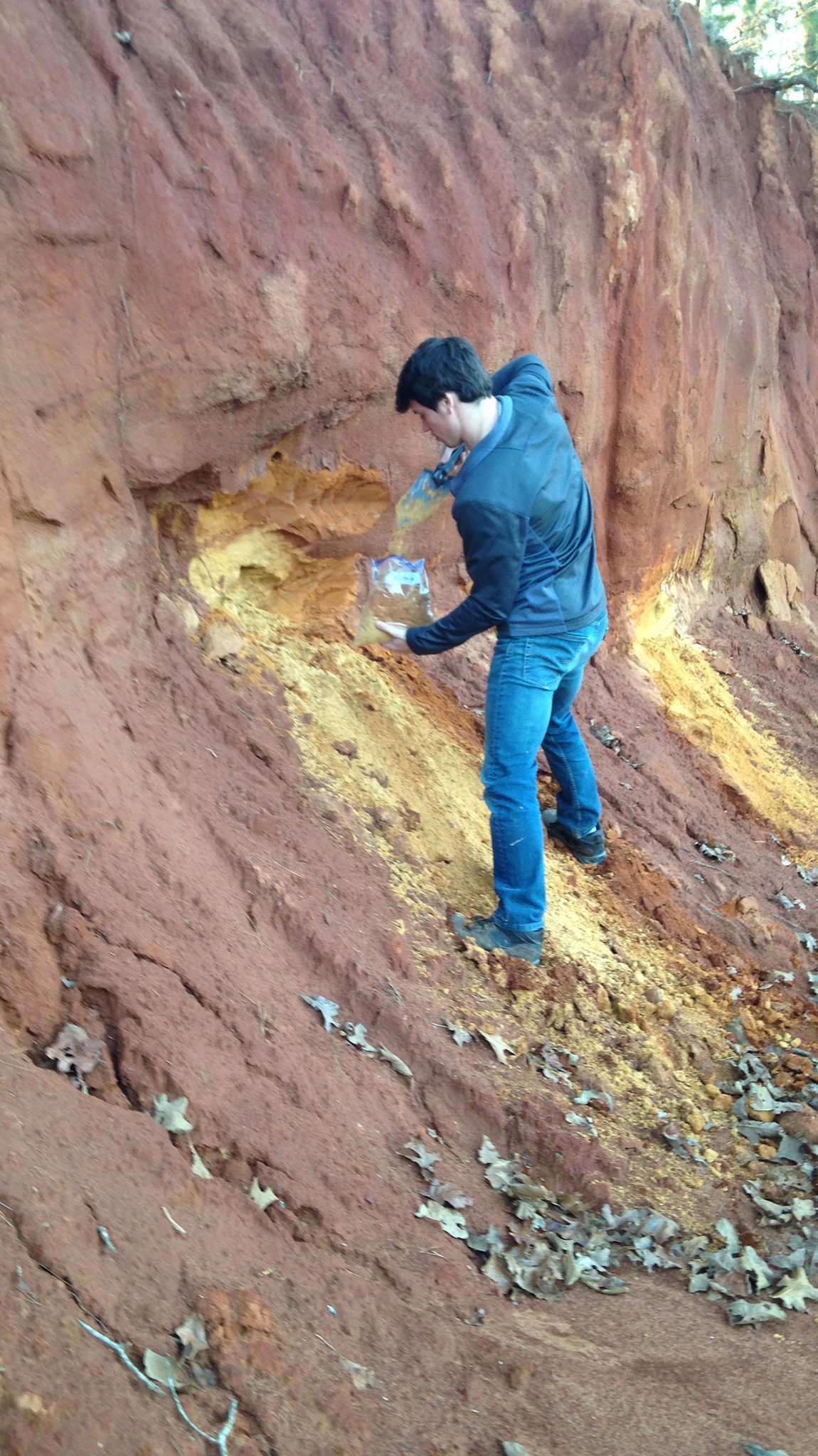
Thomas Varner takes soil samples from an embankment along the Mississippi River as part of his senior undergraduate research project. Submitted photo by Jennifer Gifford
Did the ancient Mississippi River ever flow in a different direction?
That and other questions about what Native Americans named the “Father of Waters” may soon be answered, thanks to new research being conducted by scientists at the University of Mississippi.
Thomas Varner, a senior geology and geological engineering major from South Bend, Indiana, and Jennifer Gifford, assistant professor of geology and geological engineering, are studying zircons (extremely durable heavy minerals often found as detrital grains in sedimentary rocks) to determine the river’s age and tectonic environment of origin. The project, funded by an internal UM Undergraduate Summer Research Fellowship Track 1 grant, uses detrital zircon age patterns as a tracer of sediment source.
“Through analysis of a zircon’s uranium and lead isotopic composition, it is possible to age-date and correlate the grains back to their original source locality,” Varner said. “Using that information, we can infer a piece of the depositional history of the zircon’s most recent unit. Through analyzing the age spectra of the zircons from the McNairy Sandstone to infer the depositional history of the Late Cretaceous, the goal of this project is to determine when the Mississippi River began flowing in its current north-to-south orientation.”
Before applying for the Undergraduate Summer Research grant, Varner and Gifford collected samples of the target unit, the McNairy Sandstone, from northeastern Mississippi and south central Tennessee. Two gallon-sized bags of samples were collected at each of 10 sites, predetermined outcrops of the McNairy formation. Notes about the specific location, sample lithology and details of the outcrop at each site were recorded.
Throughout the spring 2018 semester and through the summer, the pair continued to work on the project.
“After I collected the zircons from each sample, they were mounted in epoxy and then polished to expose the center of the grains,” Varner said. “I used a scanning electron microscope at another location to image the grains to be able to interpret their morphology. Once the zircons (were) imaged, analysis required travel to Fayetteville, Arkansas, to use an inductively coupled plasma mass spectrometer.”
The ICP-MS ionized a portion of the individual zircon grains, which was then analyzed for uranium and lead isotopes to calculate an age for each grain. Now that the age spectra for each sample have been obtained, Varner is working on interpreting the provenance of this section of the McNairy sandstone in comparison to that which is exposed in the Illinois Basin. He will present the findings of their study at the annual Geological Society of America scientific conference in Indianapolis in October.
“Northern Mississippi contains many Cretaceous units, some of which spread through Tennessee and Kentucky, and only three of which are present in southern Illinois, where they are thin and discontinuous,” Gifford said. “These deposits accumulated at the end of the Mesozoic because subsidence along the late Proterozoic-early Paleozoic Reelfoot Rift system created a topographic low known as the Mississippi Embayment.”
One previous detrital zircon study of Maastrichtian sandstones in the Mississippi Embayment provides important insight into the nature of depositional systems along the southern margin of Appalachia during latest Cretaceous time following the closure of the Western Interior Seaway. This project furthers another geographical study in which a major change in the dominant drainage trajectory of the ancient Mississippi River in the late Cretaceous, from west-flowing across the continent to south-flowing to the Mississippi Embayment, was observed.
“This successfully narrowed down the time span of the formation of the Mississippi River to more than 40 Ma (million years ago),” Gifford said. “Further studies support these Early Cretaceous paleogeographic interpretations.”
By analyzing further detrital zircons along the trend of the Mississippi Embayment through Mississippi, Tennessee and possibly Kentucky, Gifford and Varner hope to determine exactly when the Maastrichtian sediments were deposited during one (or more) of these transgressive cycles.
“Further data will allow for a more robust insight into the depositional patterns along the southern margin of Appalachia within the Mississippi Embayment during the Late Cretaceous, as well as the evolution of the Mississippi River into its current form and setting up the template for sediment transport that persists today,” Gifford said. “This will, in turn, allow for a better interpretation of when the Mississippi River began running north to south in its current orientation.”
For more information about the Department of Geology and Geological Engineering, visit https://engineering.olemiss.edu/gge/